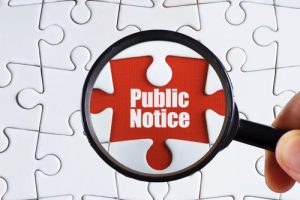FCC Emergency Alert System Advisory
PUBLIC NOTICE
DA 21-857
Enforcement Advisory No. 2021-07
Released: July 21,2021
FCC ENFORCEMENT ADVISORY
ENFORCEMENT BUREAU REMINDS EAS PARTICIPANTS OF THE OBLIGATION TO ENSURE THAT EMERGENCY ALERTS ARE ACCESSIBLE TO PERSONS WITH DISABILITIES
The Enforcement Bureau of the Federal Communications Commission (FCC or Commission) issues this Advisory to remind Emergency Alert System (EAS) Participants of the requirements to ensure that EAS alerts are visually and aurally accessible. 1
The EAS
The Emergency Alert System is a national public warning system through which broadcasters, cable television operators, wireless cable operators, wireline video service providers, satellite digital audio radio service providers, and direct broadcast satellite (DBS) providers (collectively EAS Participants) supply communications capability to the President to address the American public during a national emergency.2 In addition, state and local authorities commonly deliver important emergency information, such as weather and AMBER alerts, to affected communities using the EAS.3 EAS Participants are required to deliver national test alerts and conduct weekly and monthly tests of the system.4
What rules govern the accessibility requirements for EAS messages?
The accessibility requirements for EAS messages are contained in Section 11.51 of the Commission’s rules.5 The rules require the following:
(1) The visual message portion of an EAS alert, whether video crawl or block text, must be displayed:

(i) At the top of the television screen or where it will not interfere with other visual messages;
(ii) In a manner (i.e., font size, color, contrast, location, and speed) that is readily readable and understandable;
(iii) That does not contain overlapping lines of EAS text or extend beyond the viewable display (except for video crawls that intentionally scroll on and off the screen); and
(iv) In full at least once during any EAS message.
(2) The audio portion of an EAS message must play in full at least once during any EAS message to ensure it is accessible to viewers who are blind or have low vision.6
Who is covered by these rules?
Analog and digital television broadcast stations, analog and digital cable systems, wireless cable systems, wireline video systems, and DBS providers must transmit EAS alerts in a manner that allows individuals with and without disabilities to access the full content.7
What steps should EAS Participants take to ensure their compliance with the visual and audio requirements?
EAS Participants should take necessary steps, in compliance with Section 11.51 of the Commission’s rules, to ensure that individuals who are deaf or hard of hearing and individuals who are blind or visually impaired have full access to EAS messages. For example:
• Visual messages must be readily readable. Text should scroll at a speed that allows the viewer to read and understand the message. For example, to the extent possible, the crawl speed should allow viewers to read the crawl as if they were going to read it aloud.
• The background and text colors should sufficiently contrast to allow for readability. For example, a bright green background with white text may not provide sufficient contrast. Green and red should also be avoided as viewers who are color blind have difficulty seeing these colors.
• Audio messages should be spoken at a pace that allows for a listener to understand the content.
What is the consequence for violating the Commission’s requirements?
Failure to comply with the EAS accessibility rules may subject a violator to sanctions including, but not limited to, substantial monetary forfeitures. The Enforcement Bureau may, at its discretion, treat each failure to transmit accessible EAS messages as a separate violation for purposes of calculating the proposed forfeiture amount. The Bureau will continue to monitor and enforce compliance with the EAS accessibility rules due to their importance in promoting and protecting public safety.

The Enforcement Bureau encourages EAS Participants to enhance the accessibility of the emergency information contained in EAS alerts.
• Include a scroll in weekly tests. The rules do not require that EAS Participants include a scroll or other visual component in weekly tests. However, including a scroll in weekly tests informs all viewers, including persons with disabilities, that the station is conducting a test and reminds viewers of the EAS system.
• Ensure that all components of EAS tests and alerts are accessible and complete. Partner with accessibility groups that can serve in an advisory capacity regarding accessibility. Review tests and alerts to ensure accuracy. For example, an EAS Participant voluntarily inserted a static notice during weekly tests. However, the notice failed to indicate that a “test” was occurring, as opposed to an actual emergency. The EAS text message should not interfere with closed captions, unless the text crawl is on the top of the screen.8
• Monitor your state plan and follow specific guidance. State plans often have additional guidance that can further enhance EAS tests and alerts.
What should consumers do if they observe an inaccessible EAS message?
Consumers who believe they have observed an inaccessible EAS message may file an online complaint at www.fcc.gov/accessibilitycomplaintsform, or contact the FCC by telephone at (202) 418-2517 or by email at dro@fcc.gov. Persons who are deaf or hard of hearing can also use the ASL Consumer Support Line by calling 844-4-FCC-ASL (844) 432-2275).
For Further Information
For additional information, please visit the FCC website at https://www.fcc.gov/eas-faq-accessibility and https://www.fcc.gov/emergency-alert-system#block-menu-block-4. Media inquiries should be directed to Will Wiquist at (202) 418-0509 or will.wiquist@fcc.gov. Questions about EAS accessibility should be directed to Bill Wallace of the Disability Rights Office of the Consumer and Governmental Affairs Bureau at: (202) 418-2716, or by e-mail, at: William.Wallace@fcc.gov. Questions about EAS enforcement matters should be directed to Phillip Priesman of the Enforcement Bureau at: (202) 4181582, or by e-mail, at: Phillip.Priesman@fcc.gov. To request materials in accessible formats for people with disabilities (Braille, large print, electronic files, audio format), send an e-mail to: FCC504@fcc.gov or call the Consumer and Governmental Affairs Bureau at (202) 418-0530 (voice).
Issued by: Chief, Enforcement Bureau


